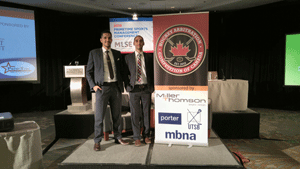
 Four law school teams are heading into the semifinals today as they debate player salaries as part of the Hockey Arbitration Competition of Canada.
Four law school teams are heading into the semifinals today as they debate player salaries as part of the Hockey Arbitration Competition of Canada.
Two teams from the Queen’s University Faculty of Law, a team from Syracuse University, and one from the University of Calgary have taken the lead in the two-day competition in Toronto.
The event is a moot competition for law students designed to simulate the salary arbitration procedures used in the National Hockey League. Teams represent one of three real-life NHL players who went through the salary arbitration process this summer. Each team takes one side of the case — the club or player — and they compete by writing briefs and making arguments on the fairness of the salary amount the player stands to receive.
This year, the players included forward Marcus Johansson of the Washington Capitals, whose midpoint salary is $3.75-million; defence man, Justin Schultz of the Edmonton Oilers, whose midpoint salary was $3.9 million; and Mike Hoffman, a forward with the Ottawa Senators whose midpoint salary was $2 million.
Nicholas Rossi, then a third-year student at the University of Toronto Faculty of Law and this year’s competition judge, created the moot in 2012.
“I got to see first-hand the quality of the competition, and the level of competition was high,” says Rossi.
He originally got the idea for the moot in his first year at the Tulane University Law School in New Orleans where a similar event took place with a focus on baseball rather than hockey.
After transferring to U of T for his second year, Rossi wanted to do something similar in Canada knowing that “people love hockey and there would be a big market for it.”
This year’s arbitration includes 32 teams with representatives from most of the law schools in Ontario and from several provinces such as Manitoba, Saskatchewan, British Columbia, Alberta, New Brunswick, and Quebec.
The interest in the moot is extremely high because “people are very passionate about hockey,” says Rossi.